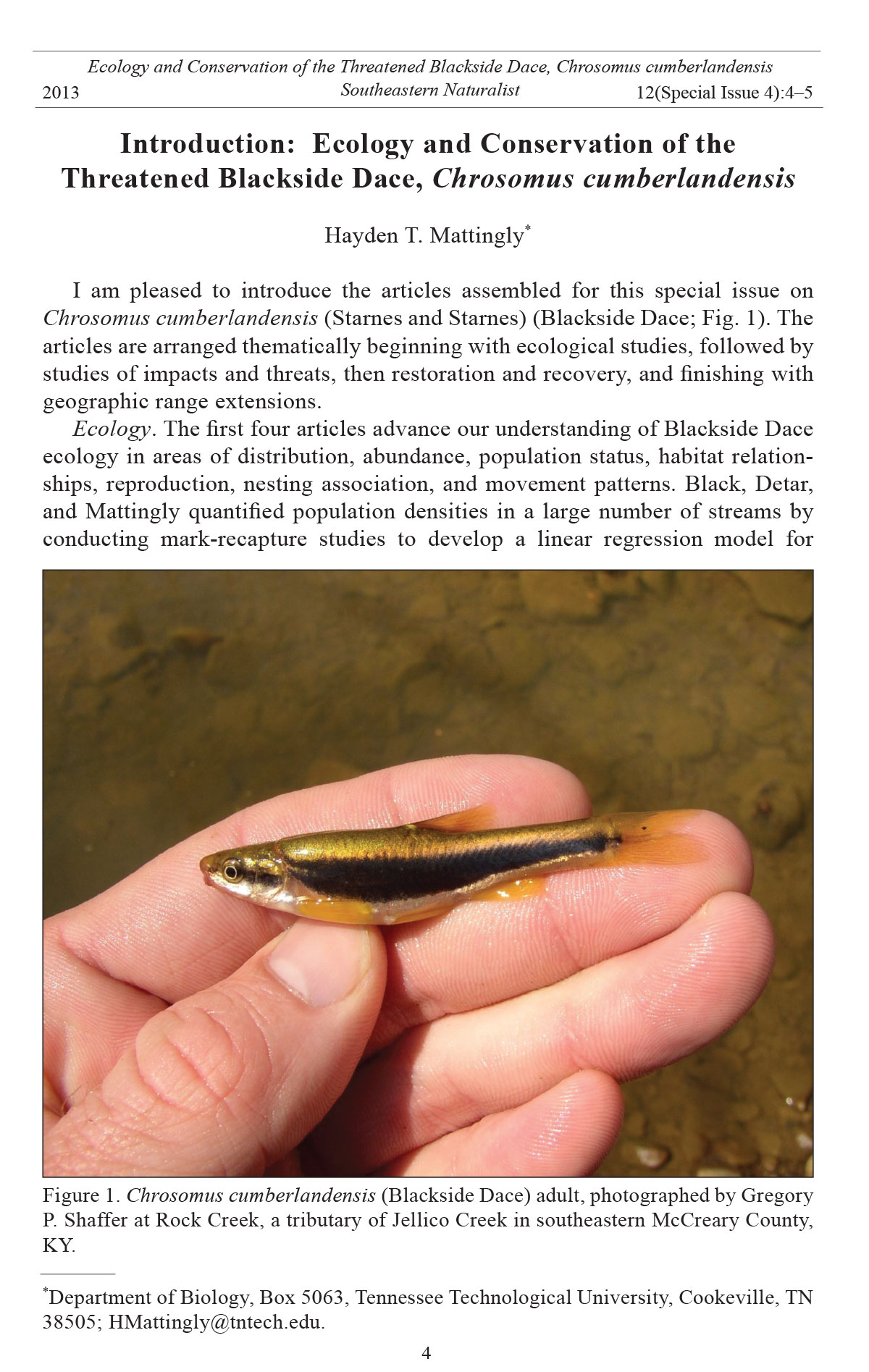H.T. Mattingly
2013 Southeastern Naturalist
4
Vol. 12, Special Issue 4
Introduction: Ecology and Conservation of the
Threatened Blackside Dace, Chrosomus cumberlandensis
Hayden T. Mattingly*
I am pleased to introduce the articles assembled for this special issue on
Chrosomus cumberlandensis (Starnes and Starnes) (Blackside Dace; Fig. 1). The
articles are arranged thematically beginning with ecological studies, followed by
studies of impacts and threats, then restoration and recovery, and finishing with
geographic range extensions.
Ecology. The first four articles advance our understanding of Blackside Dace
ecology in areas of distribution, abundance, population status, habitat relationships,
reproduction, nesting association, and movement patterns. Black, Detar,
and Mattingly quantified population densities in a large number of streams by
conducting mark-recapture studies to develop a linear regression model for
*Department of Biology, Box 5063, Tennessee Technological University, Cookeville, TN
38505; HMattingly@tntech.edu.
Ecology and Conservation of the Threatened Blackside Dace, Chrosomus cumberlandensis
2013 Southeastern Naturalist 12(Special Issue 4):4–5
Figure 1. Chrosomus cumberlandensis (Blackside Dace) adult, photographed by Gregory
P. Shaffer at Rock Creek, a tributary of Jellico Creek in southeastern McCreary County,
KY.
5
H.T. Mattingly
2013 Southeastern Naturalist Vol. 12, Special Issue 4
estimating population size based on single-pass backpack-electrofishing catch
rates. Black, Jones, and Mattingly measured stream habitat variables to identify
variables associated with Blackside Dace presence at the stream and reach spatial
scales. They developed logistic regression models and validated them with new
data at both scales. Mattingly and Black documented fish species with which
Blackside Dace are most likely to associate during reproduction, and they quantified
microhabitat conditions where reproductive events occur. In addition, they
measured substrate and water quality conditions at sites with and without active
logging disturbance. Finally, Detar and Mattingly tracked movement patterns of
marked individuals in two watersheds over an annual cycle.
Impacts and Threats. The next set of articles address impacts of selected
human and Beaver activities on Blackside Dace populations in three different
watersheds. Eisenhour and Floyd described an example of a perched road culvert
serving as a barrier to fish passage, and they documented its detrimental effects
on Blackside Dace and other species. Papoulias and Velasco described water
quality changes and fish tissue damage caused by release of hydraulic fracking
fluids into a stream occupied by Blackside Dace. Finally, Compton, Floyd, and
Stephens monitored the fish community in a stream for two decades to document
changes caused by Beaver colonization.
Restoration and Recovery. The following three articles in this special issue
describe collaborative efforts to restore and recover Blackside Dace populations.
Floyd and co-authors documented fish-community changes as part of the first
large-scale restoration project undertaken for a Blackside Dace stream. McAbee
and co-authors combined knowledge of Blackside Dace ecology and threats
with expert opinion to provide a framework to enhance recovery management of
the species. In their work, sensitivity and scenario-building analyses identified
factors most responsible for predictions of population persistence. Rakes and coauthors
complete this section with refined techniques for propagating Blackside
Dace in captivity, sharing insights regarding dace reproductive behavior.
Range Extensions. The volume finishes with two articles that revise the geographic
boundaries of the species’ known distribution. Bivens and co-authors
reported newly discovered populations in the Big South Fork drainage, representing
a downstream range extension in the Cumberland River system, while
Skelton documented populations in the upper Tennessee River, expanding the
species’ known range to an entirely new river drainage and new state, Virginia.
In the volume’s concluding essay, Mattingly and Floyd provide summary
remarks and highlight areas for future research and recovery efforts. I hope this
collection of articles informs and inspires the reader as much as I have been inspired
by working with the authors, editors, sponsors, and others to create this
special issue devoted to Blackside Dace conservation.














 The Southeastern Naturalist is a peer-reviewed journal that covers all aspects of natural history within the southeastern United States. We welcome research articles, summary review papers, and observational notes.
The Southeastern Naturalist is a peer-reviewed journal that covers all aspects of natural history within the southeastern United States. We welcome research articles, summary review papers, and observational notes.